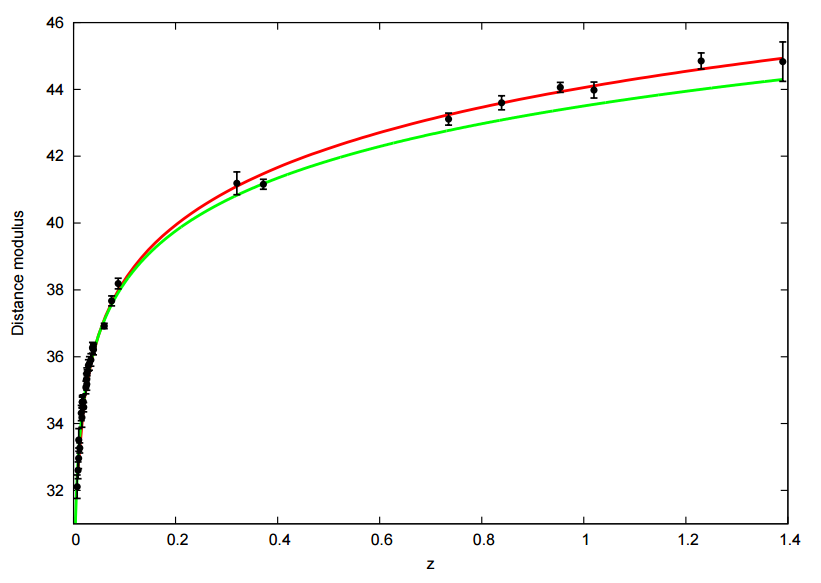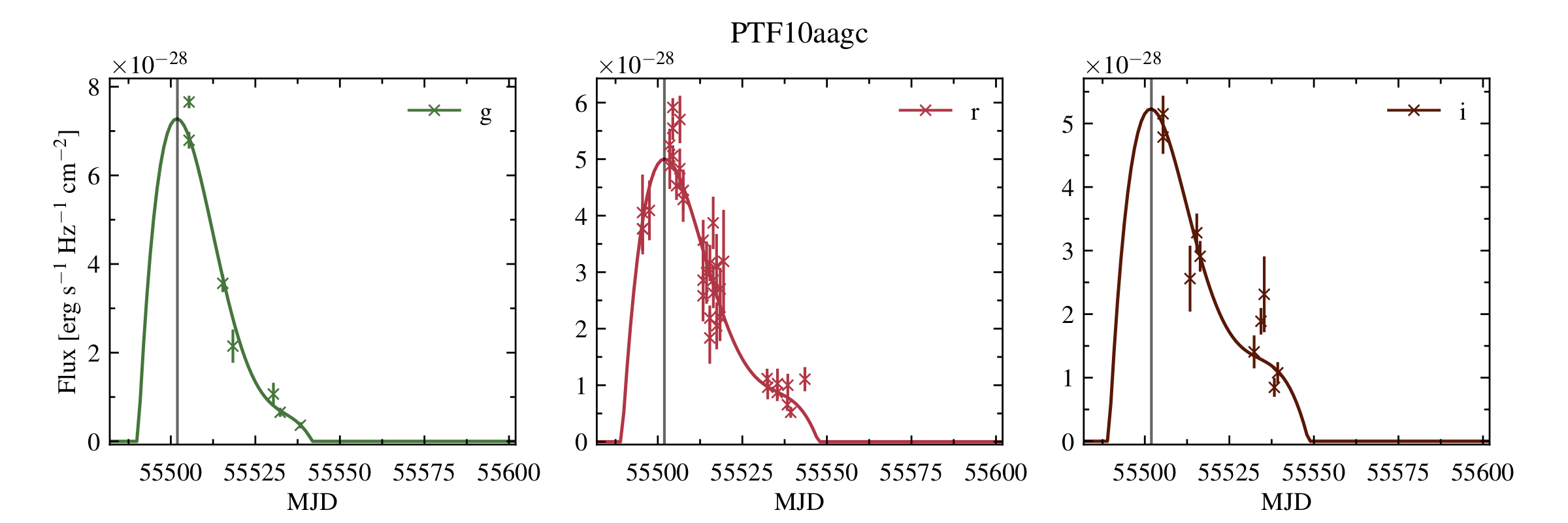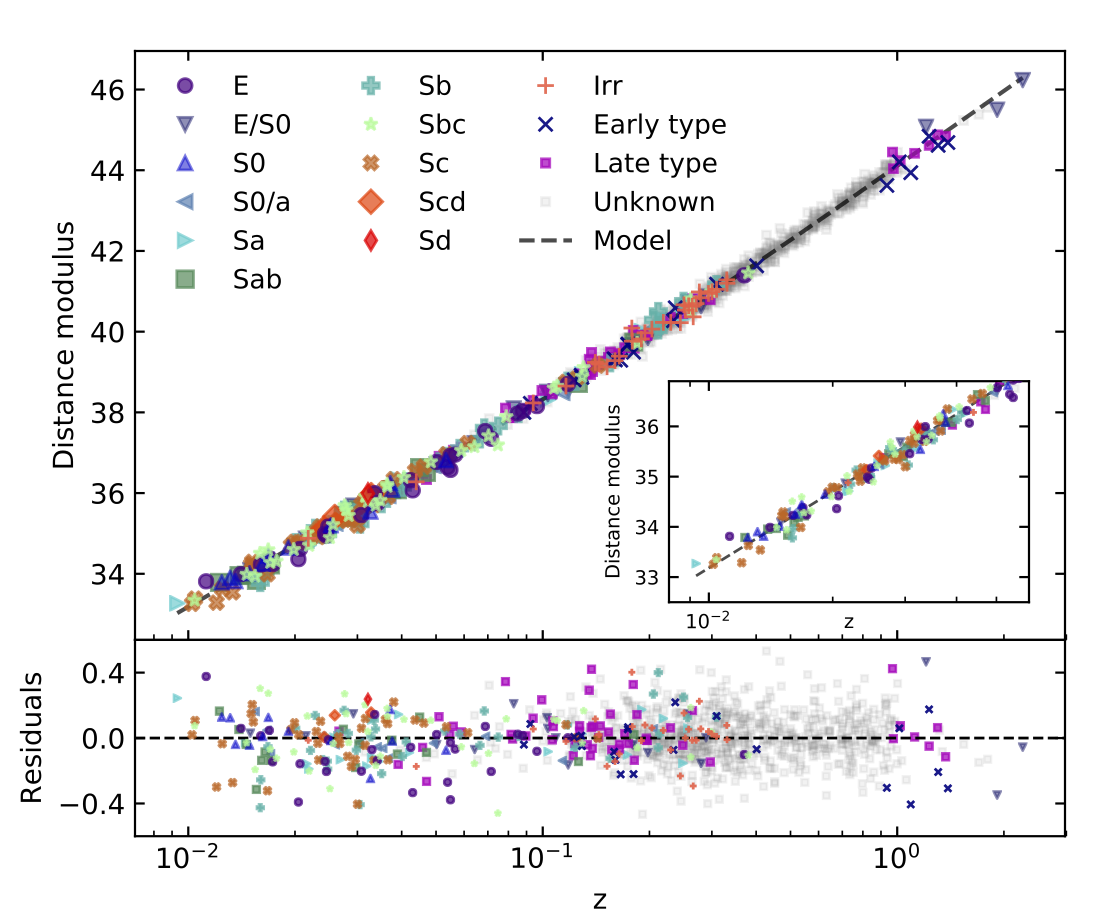The mechanism of supernova Ia explosion in elliptical galaxies
Lipunov, Panchenko & Pruzhinskaya, 2011, New Astronomy, 16, 4, pp. 250-252
The mechanism of supernova Ia explosion in elliptical galaxies
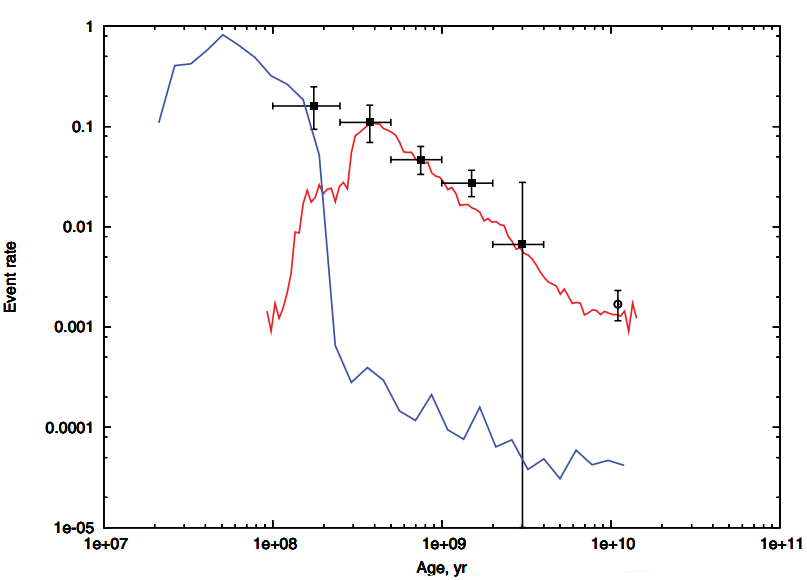
Lipunov V.M., Panchenko I.E., Pruzhinskaya M.V., 2011, New Astronomy, 16, 4, pp. 250-252
Abstract. Recent observational data on the type Ia supernova rates are in excellent agreement with the earlier results of the population synthesis of binary stars and confirm that the overwhelming majority of type Ia supernovas (≈99%) in elliptical galaxies form via mergers of binary white dwarfs with a total mass exceeding the Chandrasekhar limit.
Keywords. Galaxies: evolution, galaxies: stellar content, stars: statistics, supernovae: general
Figure. The SN Ia rate per century for a single starburst population whose total K-band luminosity is 1010 LK,Sun at the age of 11 Gyr (predicted by Jorgensen et al., 1997). The filled squares are the observational points. The open circle is observational SN Ia rate in elliptical galaxies in the local Universe (Mannuci et. al. 2006).
Scenario Machine: fast radio bursts, short gamma-ray burst, dark energy and Laser Interferometer Gravitational-wave Observatory silence
Lipunov & Pruzhinskaya, 2014, MNRAS, 440, 2, pp. 1193-1199
Scenario Machine: fast radio bursts, short gamma-ray burst, dark energy and Laser Interferometer Gravitational-wave Observatory silence
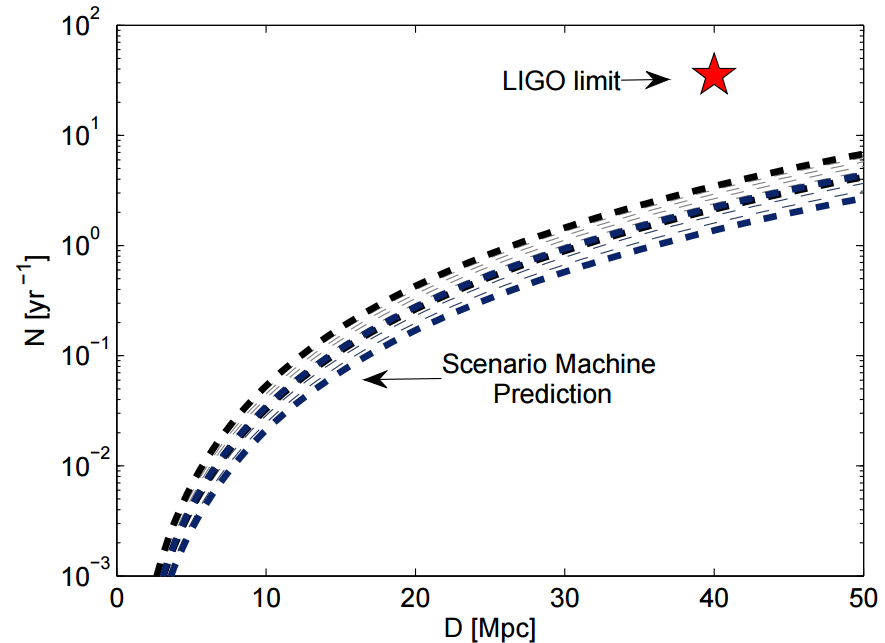
Lipunov V.M. and Pruzhinskaya M.V., 2014, MNRAS, 440, 2, pp. 1193-1199
Abstract. We discuss the recently reported discovery of fast radio bursts (FRBs) in the framework of the neutron star-neutron star (NS+NS) or neutron star-black hole (NS+BH) binary merger model. We concentrate on what we consider to be an issue of greatest importance: what is the NS merger rate given that the FRB rate (1/1000 yr–1 per galaxy) is inconsistent with gamma-ray burst rate as discussed by Thornton and should be significantly higher. We show that there is no discrepancy between NS merger rate and observed FRB rates in the framework of the Scenario Machine population synthesis — for a kick velocity of 100–150 km s–1 an average NS merger rate is 1/500–1/2000 yr–1 per galaxy up to z = 0.5–1. Based on the Scenario Machine NS merger rate estimates, we discuss the lack of positive detections on the ground-based interferometers, considering the Laser Interferometer Gravitational-wave Observatory.
Keywords. Gravitational waves, gamma-ray burst: general
Figure. The number of NS+NS mergers per year inside the sphere of distance D in terms of the Scenario Machine prediction for kick velocities in the 100–150 km s–1 interval. The black and blue curves correspond to modified Salpeter (1955) and Baldry & Glazebrook (2003) IMF, respectively. The asterisk shows the LIGO S6 limit (Abadie et al. 2012).
On the nature of rapidly fading Type II supernovae
Moriya, Pruzhinskaya, et al., 2016, MNRAS, 455, 1, pp. 423-430
On the nature of rapidly fading Type II supernovae
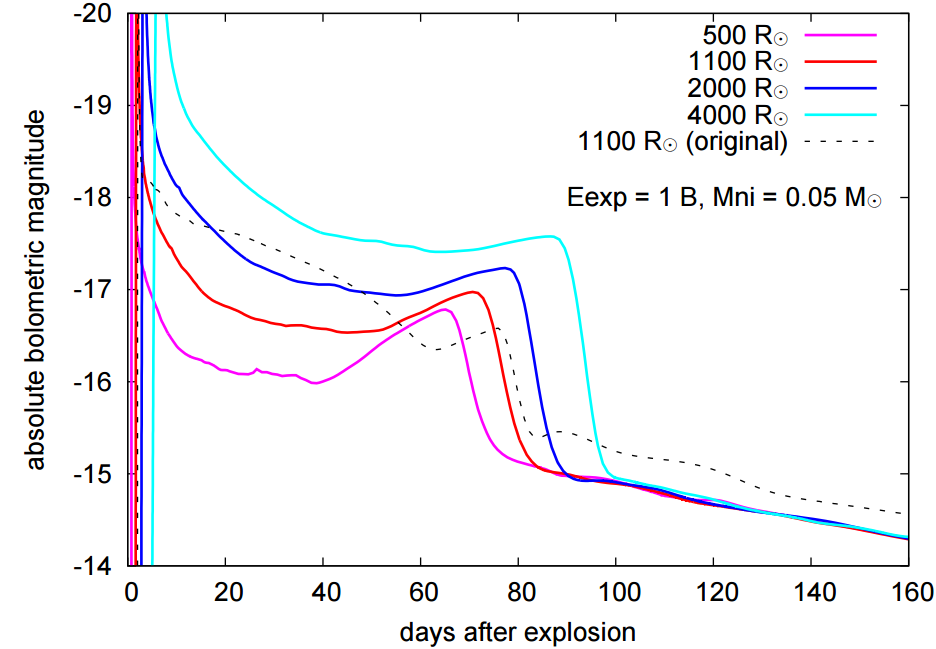
Takashi J. Moriya, Maria V. Pruzhinskaya, Mattias Ergon, Sergei I. Blinnikov, 2016, MNRAS, 455, 1, pp. 423-430
Abstract. It has been suggested that Type II supernovae with rapidly fading light curves (a.k.a. Type IIL supernovae) are explosions of progenitors with low-mass hydrogen-rich envelopes which are of the order of 1 M⊙. We investigate light-curve properties of supernovae from such progenitors. We confirm that such progenitors lead to rapidly fading Type II supernovae. We find that the luminosity of supernovae from such progenitors with the canonical explosion energy of 1051 erg and 56Ni mass of 0.05 M⊙ can increase temporarily shortly before all the hydrogen in the envelope recombines. As a result, a bump appears in their light curves. The bump appears because the heating from the nuclear decay of 56Ni can keep the bottom of hydrogen-rich layers in the ejecta ionized, and thus the photosphere can stay there for a while. We find that the light-curve bump becomes less significant when we make explosion energy larger (≳2 × 1051 erg), 56Ni mass smaller (≲0.01 M⊙), 56Ni mixed in the ejecta, or the progenitor radius larger. Helium mixing in hydrogen-rich layers makes the light-curve decline rates large but does not help reducing the light-curve bump. Because the light-curve bump we found in our light-curve models has not been observed in rapidly fading Type II supernovae, they may be characterized by not only low-mass hydrogen-rich envelopes but also higher explosion energy, larger degrees of 56Ni mixing, and/or larger progenitor radii than slowly fading Type II supernovae, so that the light-curve bump does not become significant.
Keywords. Stars: evolution, stars: massive, stars: mass-loss, supernovae: general
Figure. Bolometric LCs from simplified progenitors with different radii. We also show the original model with the same mass (Mfin = 14.0 M⊙ and Mfin = 4.1 M⊙) whose radius is 1100 R⊙.
The optical identification of events with poorly defined locations: the case of the Fermi GBM GRB 140801A
Lipunov, Gorosabel, Pruzhinskaya, et al., 2016, MNRAS, 455, 1, pp. 423-430
The optical identification of events with poorly defined locations: the case of the Fermi GBM GRB 140801A
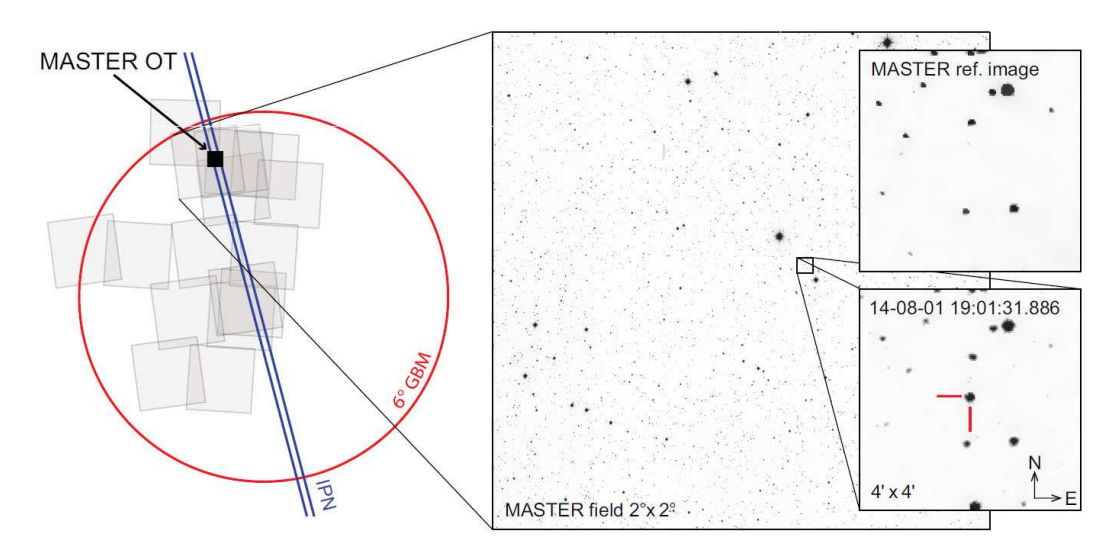
Lipunov V.M., Gorosabel J., Pruzhinskaya M.V., Postigo A. de Ugarte, Pelassa V., Tsvetkova A.E., Sokolov I.V., Kann D.A., Xu Dong, Gorbovskoy E.S., Krushinski V.V., Kornilov V.G., Balanutsa P.V., Boronina S.V., Budnev N.M., Cano Z., Castro-Tirado A.J., Chazov V.V., Connaughton V., Delvaux C., Frederiks D.D., Fynbo J.F.U., Gabovich A.V., Goldstein A., Greiner J., Gress O.A., Ivanov K.I., Jakobsson P., Klose S., Knust F., Komarova V.N., Konstantinov E., Krylov A.V., Kuvshinov D.A., Kuznetsov A.S., Lipunova G.V., Moskvitin A.S., Pal'shin V.D., Pandey S.B., Poleshchuk V.A., Schmidl S., Sergienko Yu.P., Sinyakov E.V., Schulze S., Sokolov V.V., Sokolova T.N., Sparre M., Thöne C.C., Tlatov A.G., Tyurina N.V., Ulanov M.V., Yazev S.A., Yurkov V.V., 2016, MNRAS, 455, 1, pp. 423-430
Abstract. We report the early discovery of the optical
afterglow of gamma-ray burst (GRB) 140801A in the 137 deg2
3-σ error-box of the Fermi Gamma-ray Burst Monitor (GBM). MASTER is the
only observatory that automatically reacts to all Fermi alerts. GRB
140801A is one of the few GRBs whose optical counterpart was discovered
solely from its GBM localization. The optical afterglow of GRB 140801A
was found by MASTER Global Robotic Net 53 sec after receiving the
alert, making it the fastest optical detection of a GRB from a GBM
error-box. Spectroscopy obtained with the 10.4-m Gran Telescopio
Canarias and the 6-m Big Telescope Alt-azimuth of the Special
Astrophysical Observatory of the Russian Academy of Sciences reveals a
redshift of z = 1.32. We performed optical and near-infrared
photometry of GRB 140801A using different telescopes with apertures
ranging from 0.4 to 10.4 m. GRB 140801A is a typical burst in
many ways. The rest-frame bolometric isotropic energy release and peak
energy of the burst are
Eiso = 5.54–0.24
+0.26
× 1052 erg and
Ep, rest ≃ 280 keV, respectively, which
is consistent with the Amati relation. The absence of a jet break in
the optical light curve provides a lower limit on the half-opening
angle of the jet θ = 6.1°. The observed Epeak is
consistent with the limit derived from the Ghirlanda relation. The
joint Fermi GBM and Konus-Wind analysis show that GRB 140801A could
belong to the class of intermediate duration. The rapid detection of
the optical counterpart of GRB 140801A is especially important
regarding the upcoming experiments with large coordinate error-box
areas.
Keywords. Acceleration of particles, black hole physics, magnetic field, gamma-ray: general, x-ray: general
Figure. MASTER OT discovery of GRB 140801A in the Fermi GBM error-box. The left panel illustrates the final GRB localizations (red circle: 3° of statistical error (3-σ) and 3° of systematic error GBM; blue lines: 3-σ IPN). Gray squares are fields covered by MASTER. The black square is the location of the MASTER OT. The right panels show MASTER images of the OT position: discovery image (bottom), reference image (top). The IPN localization was published after the MASTER discovery circular (Hurley et al. 2014; Gorbovskoy et al. 2014).
The influence of host galaxy morphology on properties of Type Ia supernovae from the JLA compilation
Henne, Pruzhinskaya, et al., 2017, New Astronomy, 51, pp. 43-50
The influence of host galaxy morphology on properties of Type Ia supernovae from the JLA compilation
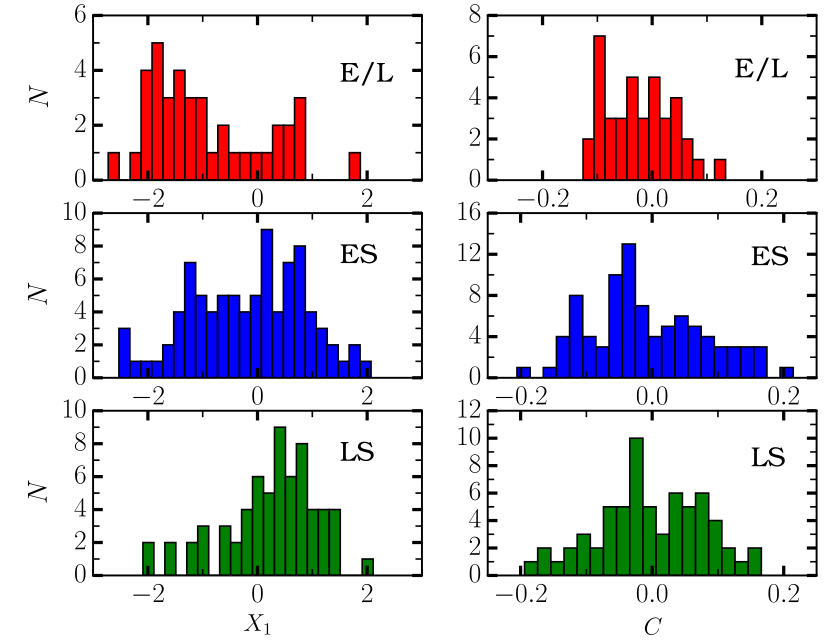
Henne V., Pruzhinskaya M.V., Rosnet P., Léget P.-F., Ishida E.E.O., Ciulli A., Gris P., Says L.-P. and Gangler E., 2017, New Astronomy, 51, pp. 43-50
Abstract. The observational cosmology with distant Type Ia supernovae (SNe) as standard candles claims that the Universe is in accelerated expansion, caused by a large fraction of dark energy. In this paper we investigate SN Ia environment, studying the impact of the nature of their host galaxies on the Hubble diagram fitting. The supernovae (192 SNe) used in the analysis were extracted from Joint-Light-curves-Analysis (JLA) compilation of high-redshift and nearby supernovae which is the best one to date. The analysis is based on the empirical fact that SN Ia luminosities depend on their light curve shapes and colors. We confirm that the stretch parameter of Type Ia supernovae is correlated with the host galaxy type. The supernovae with lower stretch are hosted mainly in elliptical and lenticular galaxies. No significant correlation between SN Ia colour and host morphology was found. We also examine how the luminosities of SN Ia change depending on host galaxy morphology after stretch and colour corrections. Our results show that in old stellar population and low dust environment, supernovae are slightly fainter. SN Ia in elliptical and lenticular galaxies have a higher α (slope in luminosity-stretch) and β (slope in luminosity-colour) parameters than in spirals. However, the observed shift is within 1-σ uncertainties and, therefore, can not be considered as significant. We confirm that supernova properties depend on their environment and that the incorporation of a host galaxy term into the Hubble diagram fit is crucial for the future cosmological analysis.
Keywords. Supernovae, cosmological parameters
Figure. The distribution of the SALT2 parameters, stretch X1 (left) and colour C (right) for different host galaxy morphology.
Multicolour modelling of SN 2013dx associated with GRB 130702A
Volnova, Pruzhinskaya, et al., 2017, MNRAS, 467, 3, pp. 3500-3512
Multicolour modelling of SN 2013dx associated with GRB 130702A
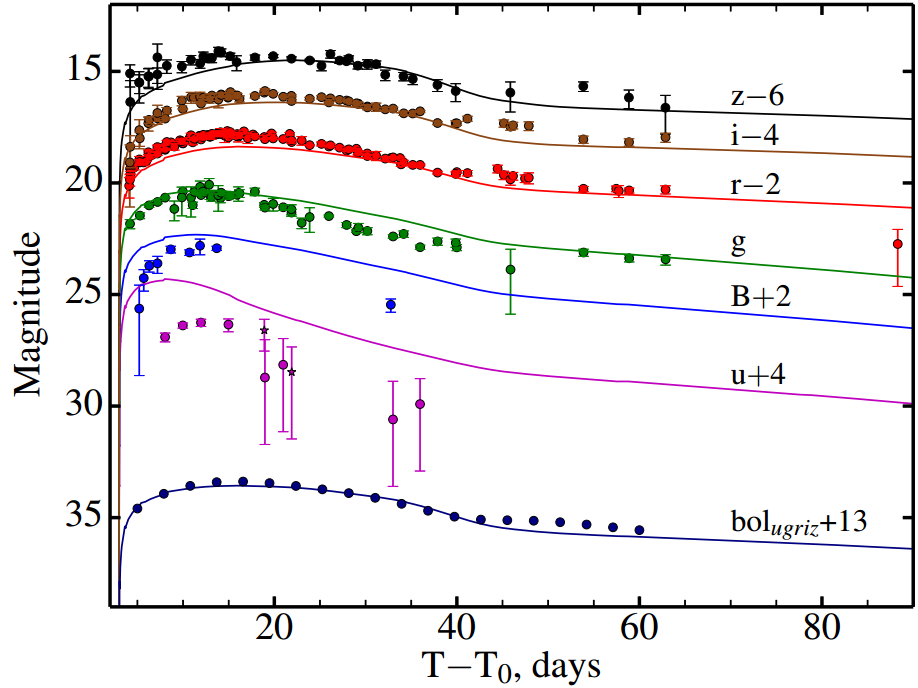
Volnova A.A, Pruzhinskaya M.V., Pozanenko A.S., Blinnikov S.I., Minaev P.Yu., Burkhonov O.A., Chernenko A.M., Ehgamberdiev Sh.A., Inasaridze R., Jelinek M., Khorunzhev G.A., Klunko E.V., Krugly Yu.N., Mazaeva E.D., Rumyantsev V.V., Volvach A.E., 2017, MNRAS, 467, 3, pp. 3500-3512
Abstract. We present optical observations of SN 2013dx, related to the Fermi burst GRB 130702A occurred at a redshift z = 0.145. It is the second-best sampled GRB-SN after SN 1998bw: the observational light curves contain more than 280 data points in uBgrRiz filters until 88 day after the burst, and the data were collected from our observational collaboration (Maidanak Observatory, Abastumani Observatory, Crimean Astrophysical Observatory, Mondy Observatory, National Observatory of Turkey, Observatorio del Roque de los Muchachos) and from the literature. We model numerically the multicolour light curves using the one-dimensional radiation hydrodynamical code STELLA, previously widely implemented for the modelling of typical non-GRB SNe. The best-fitted model has the following parameters: pre-supernova star mass M = 25 M⊙, mass of a compact remnant MCR = 6 M⊙, total energy of the outburst Eoburst = 3.5 × 1052 erg, pre-supernova star radius R = 100 R⊙, M56Ni = 0.2 M⊙ which is totally mixed through the ejecta; MO = 16.6 M⊙, MSi = 1.2 M⊙, and MFe = 1.2 M⊙, and the radiative efficiency of the SN is 0.1 per cent.
Keywords. Supernovae, gamma-ray bursts
Figure. The multicolour light curves of SN 2013dx. The Galactic extinction, the flux from the host galaxy and the optical afterglow contribution are excluded. Solid lines show the best model of the SN light curve obtained by STELLA.
Anomaly detection in the Zwicky Transient Facility DR3
Malanchev K. L., Pruzhinskaya M. V., Korolev V. S., et al., 2020, arXiv:2012.01419
Anomaly detection in the Zwicky Transient Facility DR3
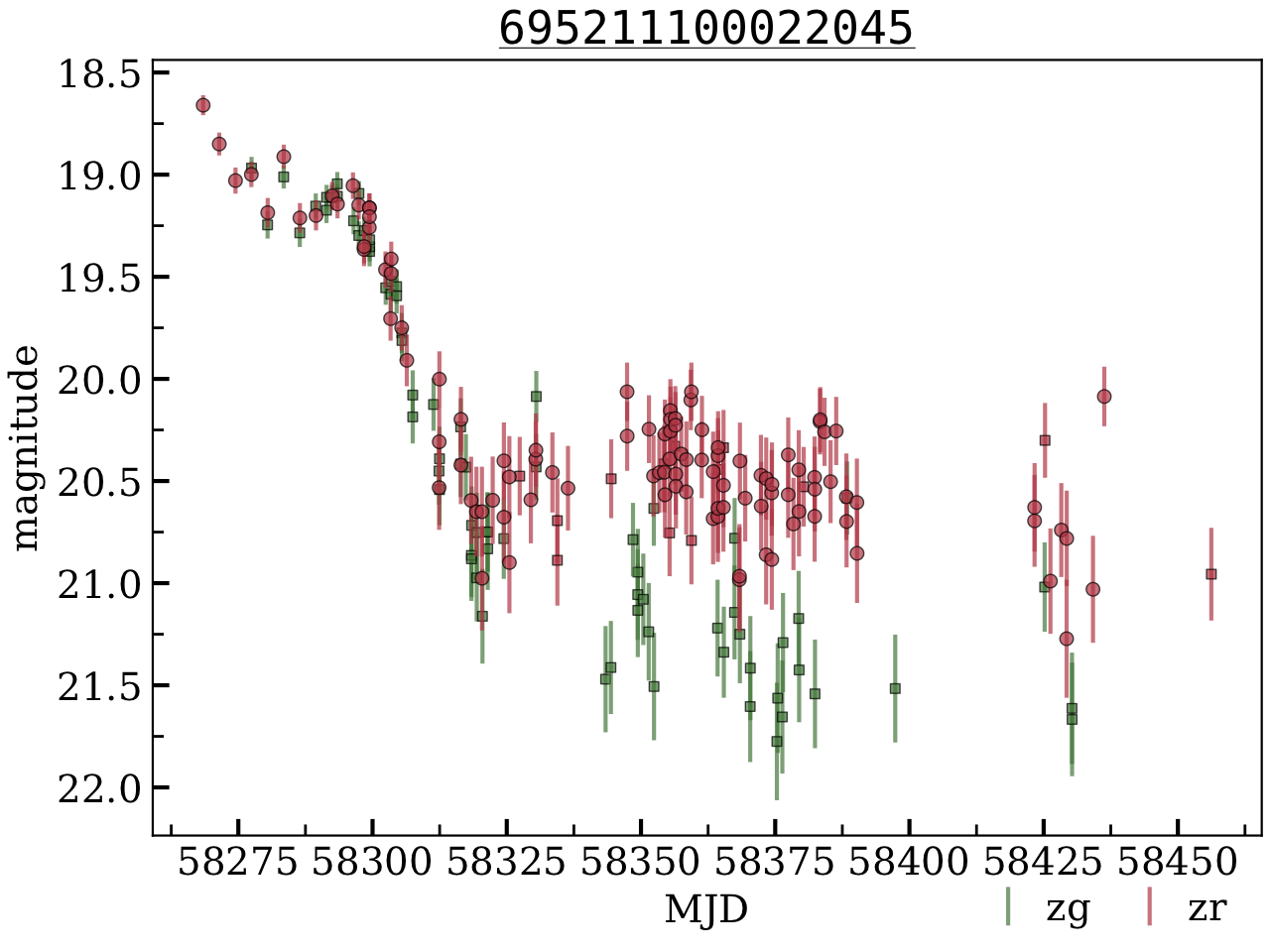
Malanchev K. L., Pruzhinskaya M. V., Korolev V. S., Aleo P. D., Kornilov M. V., Ishida E. E. O., Krushinsky V. V., Mondon F., Sreejith S., Volnova A. A., Belinski A. A., Dodin A. V., Tatarnikov A. M., Zheltoukhov S. G., 2020, arXiv:2012.01419
Abstract. We present results from applying the SNAD anomaly detection pipeline to the third public data release of the Zwicky Transient Facility (ZTF DR3). The pipeline is composed of 3 stages: feature extraction, search of outliers with machine learning algorithms and anomaly identification with followup by human experts. Our analysis concentrates in three ZTF fields, comprising more than 2.25 million objects. A set of 4 automatic learning algorithms was used to identify 277 outliers, which were subsequently scrutinised by an expert. From these, 188 (68%) were found to be bogus light curves — including effects from the image subtraction pipeline as well as overlapping between a star and a known asteroid, 66 (24%) were previously reported sources whereas 23 (8%) correspond to non-catalogued objects, with the two latter cases of potential scientific interest (e. g. 1 spectroscopically confirmed RS Canum Venaticorum star, 4 supernovae candidates, 1 red dwarf flare). Moreover, using results from the expert analysis, we were able to identify a simple bi-dimensional relation which can be used to aid filtering potentially bogus light curves in future studies. We provide a complete list of objects with potential scientific application so they can be further scrutinised by the community. These results confirm the importance of combining automatic machine learning algorithms with domain knowledge in the construction of recommendation systems for astronomy. Our code is publicly available at https://github.com/snad-space/zwad.
Keywords. Methods: data analysis, stars: variables: general, transients: supernovae, astronomical data bases: miscellaneous
Figure. The light curves of AT 2017ixs — nova candidate from the M31 field that behaves unusually for its suspected astrophysical type.
